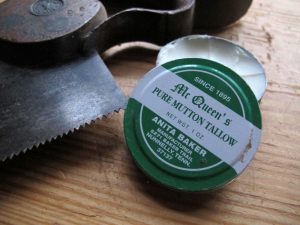We may receive a commission when you use our affiliate links. However, this does not impact our recommendations.
Ever since Roy Underhill wrote about the joys of mutton tallow as a tool lubricant in Popular Woodworking Magazine in the August 2010 issue, readers have been asking where to purchase the stuff. Or, even more alarming, how to render it themselves.
The good news is that Lee Valley Tools has started to carry McQueen’s Pure Mutton Tallow for $2.95 for a 1 oz. tin. That’s quite a bargain – on the mutton tallow black market I’ve seen it go for as much as $11.
What’s it good for? Well just about everything in the shop. I like to use it on saw blades in particular. Tallow is slicker than paraffin and doesn’t seem to wear off the blade as quickly. (OK, it’s greasier. There. I said it. But greasy is good.)
It also works well on plane soles. And Roy explained that the black coating you will find on some old wooden-bodied tools was likely from tallow.
But doesn’t it interfere with glue adhesion, finish penetration and cause sunspots? The short answer: nope. I applied some directly to some cherry a few months ago and then applied oil-based stain and finishes over it. Even though I had smeared on a good bit of the stuff, the stain still penetrated and the finish still stuck.
When you apply any lubricant to your tools, chances are that little or none of it will remain when you get to the gluing and finishing stage of your project. Remember: The cutting tool is removing the wood that you just lubricated. So it’s a non-issue, unless you abuse the stuff.
By the way, mutton tallow is also a traditional remedy for chapped skin and is the foundation for a variety of traditional ointments. You also can slick up that mustache after a day in the shop. I hear nothing is more attractive to women than the smell of lamb chops.
— Christopher Schwarz
In addition to reintroducing the world to mutton tallow, Roy Underhill has written one of my favorite articles ever published in Popular Woodworking: “Roubo’s Folding Bookstand” from the February 2011 issue. The story caused quite a stir, and if you don’t have that issue, I think it’s one to own. Buy the issue here, or the 2011 CD of all the articles from last year here.
Here are some supplies and tools we find essential in our everyday work around the shop. We may receive a commission from sales referred by our links; however, we have carefully selected these products for their usefulness and quality.











Here in Ecuador ordinary lard “manteca” is used as a general lubricant,wax is seen as too expensive to waste.I generally use beeswax myself, I have been using a 1oz. bar for a couple of years now.
I assume “Anita Baker” is the name of the lamb that graciously offered up her tallow? Is each tin emblazoned with the name of the particular lamb that contributed?
When I was an apprentice c1950s we always carried a mutton roll in our toolbox in case it rained and your saw got wet, you could then wipe it over with the mutton roll.
Mutton Roll: piece of hession 4″ wide and about 12″ to 18″ long plus as much of the mutton fat you could filch from the Sunday roast.
Spread the mutton fat over one side of the hession and then roll up tight then tie with string.
Cut off any surplus hession on one end so that the mutton fat is visible and easy to wipe down a wet saw or plane.
I still have and use a mutton roll!
Dixie Gun Works lists larger (12-16 oz)containers of mutton tallow. Under $6.
The little infomercial they have for this one on leevalley.com is great. Rob Lee is singing Frank Zappa’s “Keep it Greasy” karaoke style while suggestively plunging brass screws into a little pot of this stuff.
I just got my first Super Woobie; I think I’ll try it for awhile before I try the sheep tallow.
A first for me. A Lee Valley product only available in the US. Pity.
(Probably more about importing some class of food product than anything else.)
Ian Wigle
Toronto
It is traditional to use a candle to lubricate plane soles here in England. They were made from tallow with some beeswax but these days candles are often made with parafin based waxes and these work well. I have recently discovered that tallow is also used as a flux when soldering the lead framing of stained glass windows. Still available as a “candle” for this purpose, but without the wick, I used one yesterday and it works very well indeed. A candle is a much more convenient way of applying this excellent lubricant to a plane sole than wax from a tin. Happy Easter
I always come here for the old-timey tips and double entendre. OK, maybe sometimes it’s single entendre, but still…
Channel swimmers have been using tallow to grease up with since Capt. Webb first swam the English Channel in 1873.
From “Building and Using a traditional Scottish Caber”, by Roy Underhill:
“Our Highland Gentleman would then grease his bare chest with the tallow, to promote release and squeak out that extra groat’s distance from the caber. This is why historic examples of the caber have black staining towards the held end.”